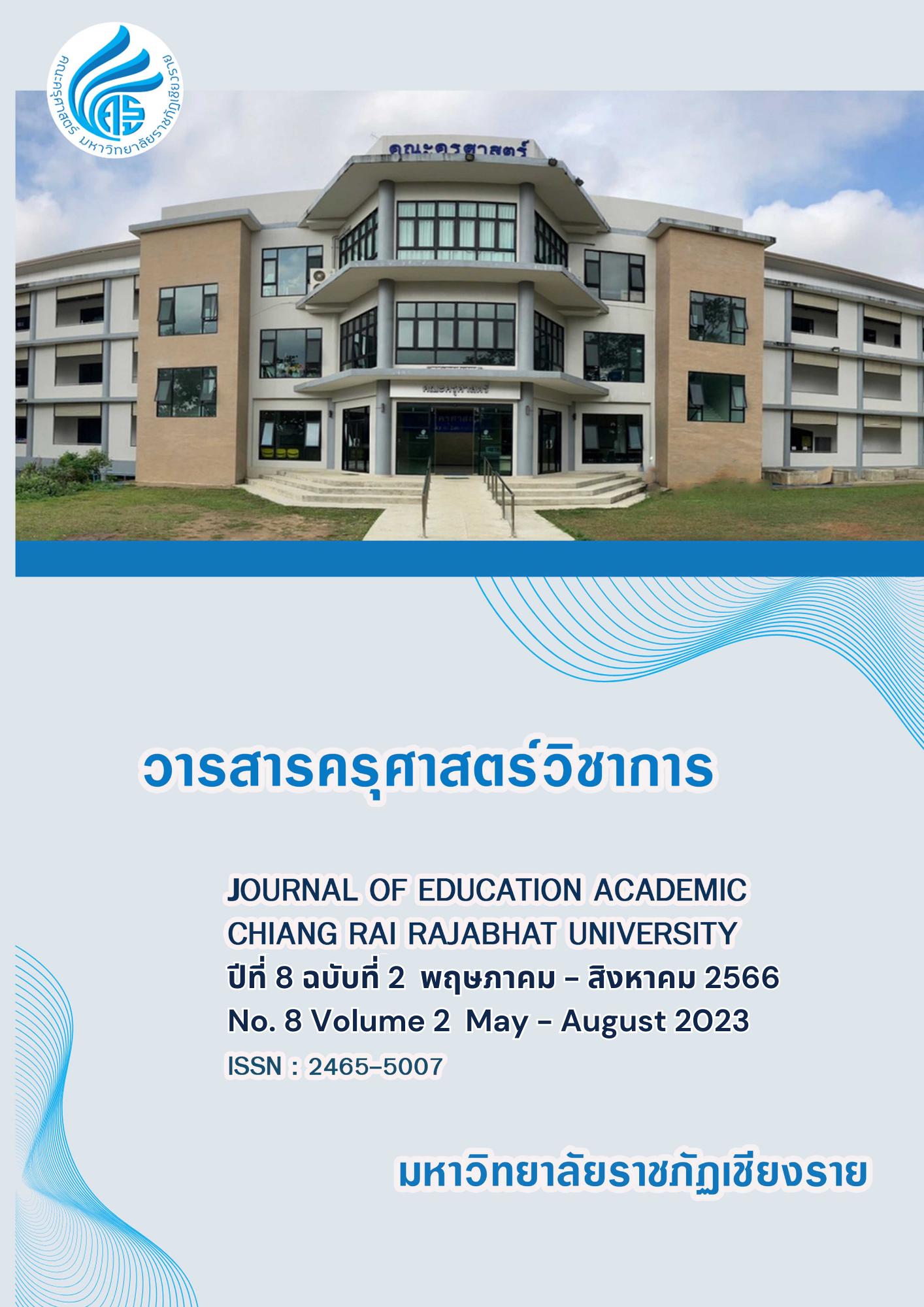Development and Inspection for Measuring Instruments of Creative Problem Solving of Students-Teachers' Professional
Keywords:
Creative Problem-Solving Abilities, Confirmatory Factor Analysis, Students-Teachers' Professional, Measuring InstrumentsAbstract
This research aims to 1) develop measuring instruments of creative problem solving of students-teachers' professional, and 2) examine the quality of measuring instruments of creative problem solving of students-teachers' professional. The sample group were 404 people of students-teachers' professional by using convenience sampling method. The research tools were measuring instruments of creative problem solving of students-teachers' professional. Analyze data using inferential statistics, internal consistency values, cronbach’s alpha and confirmatory factor analysis. The results found that, the questionnaires for creative problem solving of students-teachers' professional were consist of 2 parts: Part 1: Basic information of the respondents using a checklist and Part 2: measuring instruments of creative problem solving of students-teachers' professional It is a 5-level rating scale with 30 items classified according to 6 components. Including of 1) the ability to understand the situation 2) the ability to identify problems 3) the ability to find solution 4) the ability to select or create methods 5) the ability to design an implementation plan 6) the ability to review plans. The content validity was between 0.73 – 1.00 and the reliability of each component was between .850-.915. The results of construct validity by confirmatory factor analysis found that, the creative problem-solving model of students-teachers' professional were consistent with the empirical evidence which have = 676.120, df=387, p-value= .000, RMSEA= .043, TLI=0.959, CFI=.963, SRMR=.034
References
กุลธิดา อ่อนมี, จตุพล ยงศร และจักรกฤษณ์ โปณะทอง. (2563). การศึกษาทักษะการแก้ปัญหาเชิงสร้างสรรค์ สําหรับนักศึกษาคณะครุศาสตร์มหาวิทยาลัยราชภัฏกลุ่มภาคกลางตอนบน. วารสารสันติศึกษา ปริทรรศน์ มจร, 8(3), 981-994.
นลินทิพย์ คชพงษ์ (2561). การพัฒนารูปแบบการจัดการเรียนรู้เชิงจิตวิทยาเพื่อเสริมสร้างการแก้ปัญหาอย่างสร้างสรรค์สำหรับนักศึกษาวิชาชีพครู. (ปริญญานิพนธ์ปรัชญาดุษฎีบัณฑิต) . กรุงเทพฯ: มหาวิทยาลัยศรีนครินทรวิโรฒ.
บุญชม ศรีสะอาด. (2560). การวิจัยเบื้องต้น. (พิมพ์ครั้งที่ 10). กรุงเทพฯ: สุวีริยาสาส์น.
พรรณิสรา จั่นแย้ม. (2558). การพัฒนาชุดกิจกรรมด้วยกลยุทธ์เกมมิฟิเคชั่นและผังความคิดกราฟิกแบบร่วมมือออนไลน์ในการเรียนโดยใช้โครงงานี้เป็นฐานเพื่อเสริมสร้างความสามารถการแก้ปัญหา อย่างสร้างสรรค์เชิงธุรกิจและจริยธรรมของนักศึกษาปริญญาตรีสาขาบริหารธุรกิจ. (ปริญญานิพนธ์ปริญญามหาบัณฑิต). กรุงเทพฯ: จุฬาลงกรณ์มหาวิทยาลัย.
พระมหาตุ๋ย ขนฺติธมฺโม (คำหน่อ) และพระสมุห์พุฒิพงษ์ พุทฺธิวํโส (กล่ำทวี). (2564). บทบาทครูในศตวรรษที่21 “ครูผู้สร้างคน”. วารสารภาวนาสารปริทัศน์. 1(3), 13-26.
มณีรัศมิ์ พัฒนสมบัติสุข. (2564). การตรวจสอบคุณภาพเครื่องมือวิจัยทางการพยาบาลและสังคมศาสตร์. วารสารเครือข่ายวิทยาลัยพยาบาลและการสาธารณสุขภาคใต้. 8(2), 329-243.
ศิริชัย กาญจนวาสี. (2544). ทฤษฎีการทดสอบแบบดั้งเดิม. กรุงเทพฯ: จุฬาลงกรณ์มหาวิทยาลัย.
สมบัติ ท้ายเรือคำ. (2559) การพัฒนาแบบสอบถามและแบบวัดทางจิตวิทยา. วารสารวิจัยเพื่อพัฒนาสังคมและชุมชนมหาวิทยาลัยราชภัฏมหาสารคาม, 3(1), 35-48.
เสมอการญจน์ โสภณหิรัญรักษ์. (2557). ปัจจัยในการจัดการเรียนการสอนแบบผสมผสานและ กระบวนการเรียนรู้แก้ปัญหาเชิงสร้างสรรค์ที่ส่งผลต่อความสามารถการแก้ปัญหาเชิง สร้างสรรค์ของนิสิตนักศึกษาครุศาสตร์ศึกษาศาสตร์. (ปริญญานิพนธ์ปริญญาดุษฎีบัณฑิต). กรุงเทพฯ: จุฬาลงกรณ์มหาวิทยาลัย.
Bollen, K. A. (1989). Structural equations with latent variables. New Jersey: Wiley.
Echos, S. (2021). Design Thinking: A Core Skill for A Post VUCA World. Retrieved 15 January 2023 from https://schoolofdesignthinking.echos.cc/blog/2021/01/ design- thinking-a-core-skill-for-a-post-vuca-world/
Fan, X., & Sivo, S. (2005). Sensitivity of fit indexes to misspecified structural or measurement model components: Rationale of two-index strategy revisited. Structural Equation Modeling, 12(3), 343-367.
Lewin, J. E., & Reed, C. A. (1998). Creative problem solving in occupational therapy. Philadelphia: Lippincott-Raven Publishers.
Osborn, A. F. (1957). Applied the imagination: principles and procedures of creative thinking. New York: Scribner.
Torrance, E. P. (1965). Rewarding Creative Behavior. Englewood Cliff. New Jersy: Prentice Hall.
Treffinger, D. J. (1995). Creative Problem Solving: Overview of Educational Implications. Educational Psychology Review. 7, 301-312.
Waltz, C. F., Strickland, O. L., & Lenz, E. R. (2010). Measurement in Nursing and Health Research (4thed.). New York: Springer.
Downloads
Published
Issue
Section
License
Copyright (c) 2023 Journal of Education Academic Chiang Rai Rajabhat University

This work is licensed under a Creative Commons Attribution-NonCommercial-NoDerivatives 4.0 International License.






